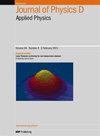优化硅异质结太阳能电池中的电荷传输和带偏移:TiO2 接触沉积温度的影响
IF 3.2
3区 物理与天体物理
Q2 PHYSICS, APPLIED
引用次数: 0
摘要
载流子选择性触点是制造硅异质结太阳能电池(SHSCs)的首要条件。二氧化钛具有良好的光电特性,如合适的带偏移、功函数和成本效益,因此在异质结太阳能电池中是一种重要的载流子选择性触点。在此,我们采用 Al/TiO2/p-Si/Ti/Au 器件配置制造了简单的 SHSC。利用原子层沉积法在 p 型硅衬底上沉积了 3 nm 的超薄 TiO2 层。TiO2 层的沉积温度从 100 °C 到 250 °C 不等。X 射线光电子能谱研究表明,沉积温度对二氧化钛的化学态有很大影响,并降低了费米能处缺陷态密度的形成。当沉积温度升高时,TiO2 层的光带隙值也从 3.13 eV 变为 3.27 eV。在二氧化钛层中还观察到工作函数从-5.13 eV调谐到-4.83 eV,这表明费米级调谐的变化是由于在较高温度下载流子浓度的变化引起的。为了理解沉积温度对光伏器件性能的影响,我们对ideality factor、阱密度、反向饱和电流密度、势垒高度等器件参数进行了量化。结果表明,沉积温度对电荷传输和器件性能有重大影响。在最佳温度下,电荷载流子重组和阱态密度显著降低,有助于提高功率转换效率。本文章由计算机程序翻译,如有差异,请以英文原文为准。
Optimizing charge transport and band-offset in silicon heterojunction solar cells: impact of TiO2 contact deposition temperature
Carrier selective contacts are a primary requirement for fabricating silicon heterojunction solar cells (SHSCs). TiO2 is a prominent carrier selective contact in SHSCs owing to its excellent optoelectronic features such as suitable band offset, work function, and cost-effectiveness. Herein, we fabricated simple SHSCs in an Al/TiO2/p-Si/Ti/Au device configuration. Ultrathin 3 nm TiO2 layers were deposited onto a p-type silicon substrate using the atomic layer deposition method. The deposition temperature of TiO2 layers varied from 100 °C to 250 °C. X-ray photoelectron spectroscopic studies suggest that deposition temperature highly affects the chemical states of TiO2 and reduces the formation of defective state densities at the Fermi energy. The optical band gap values of TiO2 layers are also altered from 3.13 eV to 3.27 eV when the deposition temperature increases. The work function tuning from −5.13 eV to −4.83 eV has also been observed in TiO2 layers, suggesting the variation in Fermi level tuning, which arises due to changes in carrier concentrations at higher temperatures. Several device parameters, such as ideality factor, trap density, reverse saturation current density, barrier height, etc, have been quantified to comprehend the effects of deposition temperature on photovoltaic device performance. The results suggest that the deposition temperature significantly influences the charge transport and device performance. At an optimum temperature, a significant reduction in charge carrier recombination and trap state density has been observed, which helps to improve power conversion efficiency.
求助全文
通过发布文献求助,成功后即可免费获取论文全文。
去求助
来源期刊
CiteScore
6.80
自引率
8.80%
发文量
835
审稿时长
2.1 months
期刊介绍:
This journal is concerned with all aspects of applied physics research, from biophysics, magnetism, plasmas and semiconductors to the structure and properties of matter.

 求助内容:
求助内容: 应助结果提醒方式:
应助结果提醒方式:


